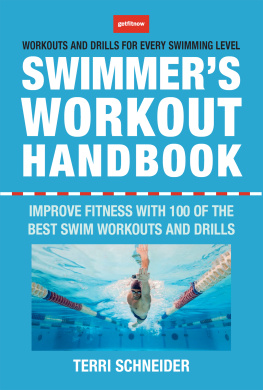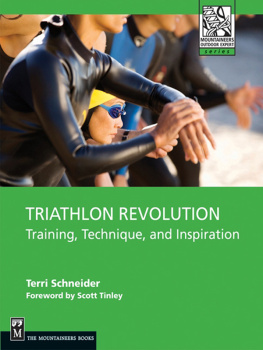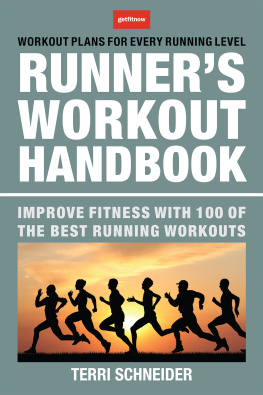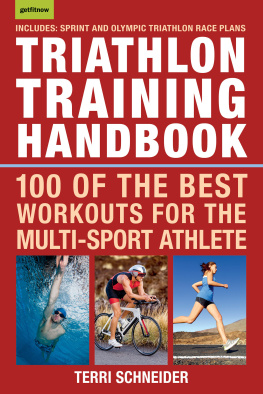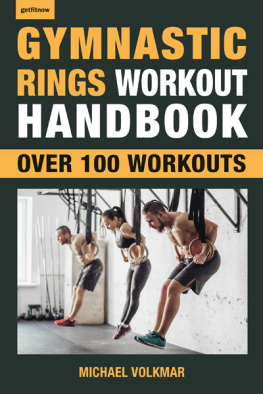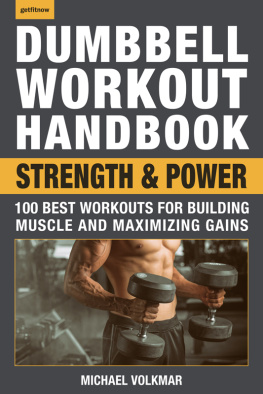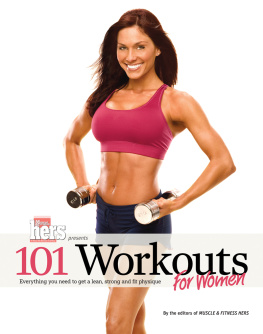
Hatherleigh Press is committed to preserving and protecting the natural resources of the earth. Environmentally responsible and sustainable practices are embraced within the companys mission statement. Visit us at www.hatherleighpress.com and register online for free offers, discounts, special events, and more. The Swimmers Workout Handbook Text Copyright 2017 Terri Schneider Library of Congress Cataloging-in-Publication Data is available. ISBN: 978-1-57826-682-1 All rights reserved. No part of this book may be reproduced, stored in a retrieval system, or transmitted, in any form or by any means, electronic or otherwise, without written permission from the publisher.
B OOK DESIGN BY C AROLYN K ASPER Printed in the United States 10 9 8 7 6 5 4 3 2 1 CONTENTS
BENEFITS
OF FITNESS
SWIMMING
Benefits of Fitness Swimming W hether you are a beginner working to increase your fun and fitness, or a veteran swimmer looking to add motivation and challenge into your training, the 100 organized swim sessions in The Swimmers Workout Handbook are for you. Ive spent years doing organized swim workouts, or standing on the pool deck coaching a masters swim group, while at the same time noticing many of the other lap swimmers in the pool going back and forth, with no apparent plan. Consistent swimming of any sort will buildand then stabilizeyour fitness, and is a fabulous non-weight-bearing activity. In order to get stronger and faster, without the mind-numbing boredom of staring at that black line, a well-planned, diverse workout is in order. The Swimmers Workout Handbook gives you the new edge you are looking for, while putting big doses of variety into each workout. Swimming improves core, muscular, and cardiovascular strength and endurance, all in a low-impact, gravity-free workout.
If done two to several times per week, or as an addition to a multi-sport training regime, swimming helps maintain a healthy weight, heart, and lungs. These benefits are best realized within the diversity of your workouts. To increase your swim fitness it is optimal to vary intensity, interval distances, recovery, and strokes, all within one workout session. The diversity within a workout is what triggers the body to grow stronger, faster, and more proficient. Whether you only have time to swim 1000 meters/yards, or are up for 5000 at each session, The Swimmers Workout Handbook organizes speed, distance, and technique into these 100 fun and challenging training sessionsputting vitality back into your pool time.
GENERAL
TERMS AND
GUIDANCE
Gear Requirements Swimsuit: There are too many types and brands of suits to list here, but the main objective is to find a suit that is comfortable, streamlined in the water, and that you enjoy wearing.
Some use their suits to make a fashion statement at every workout, while others wear an inexpensive suit even after it starts to sag in the butt due to dissolving elastic. Whichever your style, choose a suit that feels comfortable in the water. Goggles: Goggles not only protect your eyes in salt water or chemical-infused water, but they help you see clearly both above and below the water while swimming. Goggles need to fit your face and be comfortable to wear for long periods of time. If they are adjustable in the nose piece and head strap, you have a better chance of working them to prevent leaking or fogging. Try them on in the store.
If they hug your eye area with ease, make the purchase. You may need to try a few pairs before you find the one brand that works on your face. When testing the goggles in the water, adjust them to feel snug, but comfortable. Some goggles have fog-resistant residue built into each lens. Additional ways to prevent fogging are to spit in the lenses and swish the spit around, or use a defog product (as directed on the package), then dip them in water before putting them on. Try wearing the goggles for half or more of your swim workout without taking them off; they should feel comfortable after this length of time.
If they start to bother your face or feel like they are causing discomfort on your eyes, adjust the strap to ease the pressure. If you cant relieve this discomfort or eliminate leaking or fogging, get another pair and start over. For outdoor swimmers with eyes that are very sensitive to sunlight, opt for a darker lens. You can wear a lighter lens for early morning or evening swims, but youll want the darker lens for midday swimming when there is a strong possibility that the sun will hit you in the face. Swim cap: Your swim cap helps keep your head streamlined and insulated in the water and also keeps your hair out of your face. When you purchase a swim cap, choose one that doesnt pull your hair when you put it on, and stays on your head when swimming long distances.
A popular choice is silicone. They are comfortable, longer lasting, and warmer than light-weight rubber swim caps, but they do cost a bit more. Some opt for lycra swim caps for comfort, but take note that water can move through a lycra cap, making your head much less streamlined in the water than a sealed rubber cap. Earplugs: Some would consider earplugs to be optional, but for a few reasons, all swimmers should wear them. When your ear is regularly exposed to excess moisture, water can remain trapped in your ear canal. The skin inside can become waterlogged, diluting the acidity that normally prevents infection.
The soggy skin will also more readily allow bacteria to penetrate your skin. Bacteria and fungi from contaminated water can grow and cause swimmers ear, which is an infection of your outer ear and ear canal. All of the above can be prevented by using earplugs during your swimming workouts. Earplugs are available in two varieties: soft moldable silicone plugs and pre-molded rubber plugs. As with goggles, earplug brand and type is a personal preference. Use the type that is comfortable for you and keeps the water out of your ears.
Kickboard: Use a kickboard for kick sets in training, but also learn to do kick sets without a board. When using a kickboard, wrap the fingers of both hands around the top of the board and extend your arms out and over your head. Your forearms will naturally rest on top of the board. Pull buoy: Place the pull buoy between your legs at the top of your thighs. Using a pull buoy draws the legs up behind you and will help you focus on how your upper body affects your stoke. Paddles: Paddles are most often used with a pull buoy, but you can play with using them without a buoy, as desired.
There are a variety of paddle sizes and styles to choose from. If you are new to paddles, choose a smaller paddle to start. Using swim paddles not only requires you to move your arms and hands effectively through the water, but they will help you gain strength. However, only use swim paddles if you have no shoulder issues as they can put extra stress on the shoulder. Fins: Use fins or short fins to strengthen your legs and teach yourself proper body position in the water (particularly when doing drills). Just like paddles or the pull buoy, fins can be an excellent teaching aid but should not be the focus of your swim workouts.

